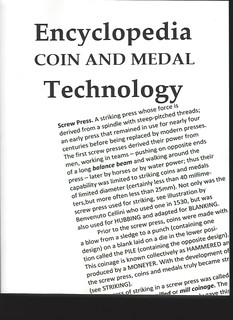
PREV ARTICLE
NEXT ARTICLE
FULL ISSUE
PREV FULL ISSUE
BOOK REVIEW: ENCYCLOPEDIA OF COIN AND MEDAL TECHNOLOGY
Gary Beals submitted this review of the draft of Dick Johnson's Encyclopedia of Coin and Medal Technology. Thanks! -Editor
For example, do you know what extrusion dwell means? It means that when dies come down on a coin blank they don't just go bang, they pause for a microsecond while squeezing the planchet. That tiny fraction of a second pause, or dwell, in a coining press cycle is to prevent the metal from springing back by molecular memory. Who would have thought gold, silver and copper could do that? In simple terms, apparently all materials want to stay as they are. I will be demonstrating this at my next talk on coins with slices of bread. When I bang my fist into a slice, most of the impression will pop back. But if I shove my knuckles into the slice and pause there a few seconds, the image on my fingers will stay on the bread. Well, extrusion dwell is just one of the things I found fascinating in Dick's book. As someone who is writing a dictionary, I come to understand the difference between a numismatic encyclopedia and just a dictionary. In my past life as an advertising man, I was always explaining to clients that an ad or brochure needed a 5 second read and a 5 minutes read. Dick's big book does that. It starts with a clear, brief meaning of a term. If that is all you need, great. But then he gives you some interesting how and why of the device or process. And often the history about how it was developed. Dick's decades of work in the artistic medals field shines through here. Few of us think of the difficulty involved in making a high relief medal. We learn that it takes three or four strikes with the dies to complete a medal. Each strike causes the metal to become work-hardened. So the metal must be softened by heating it in a furnace and then allowing it to cool before each strike. Sometimes an initial die is needed to get the high relief struck up, and then a die with the fine detail is used for completing the piece. I won't be looking at medals the same anymore. The only down-side of this book is that it does not discuss paper money, only metal numismatics. It indirectly touches upon banknotes, however, as the engraver's art is explained in great detail, and that sometimes includes making intaglio plates as well as coin dies. If you are the kind of person who enjoys saying “Wow – I had no idea that works that way” this massive book is for you. Dick Johnson sent years preparing it, you will spend weeks reading it. Gary Beals
To read the earlier E-Sylum article, see:

Wayne Homren, Editor The Numismatic Bibliomania Society is a non-profit organization promoting numismatic literature. See our web site at coinbooks.org. To submit items for publication in The E-Sylum, write to the Editor at this address: whomren@gmail.com To subscribe go to: https://my.binhost.com/lists/listinfo/esylum All Rights Reserved. NBS Home Page Contact the NBS webmaster 
|
